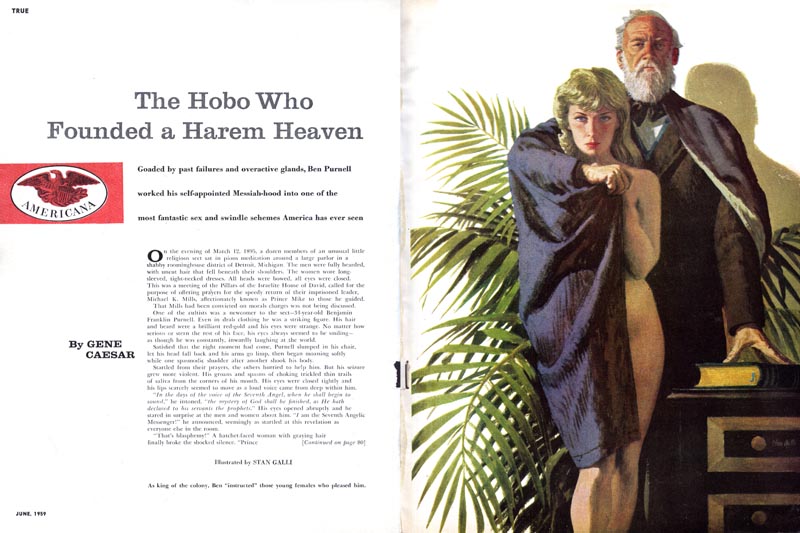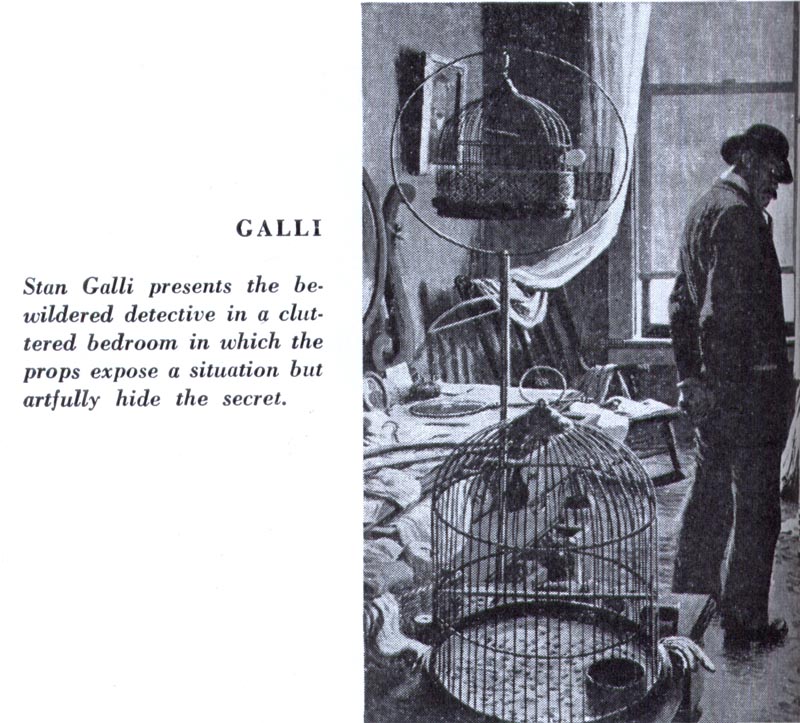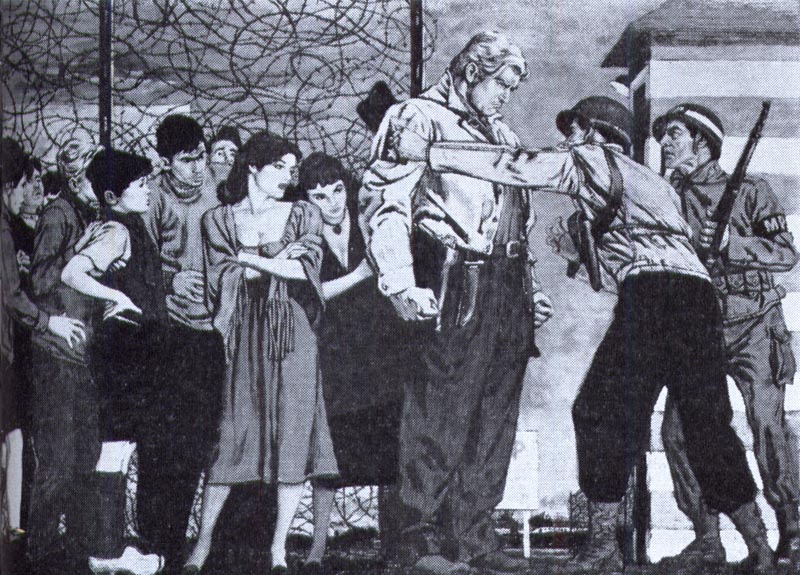
"The selection of an illustrator depends on the character of the story, on the art editor's appraisal of the artist's past performances and, of course, on the illustrator's availability. Whenever practical, the illustrator is called in to discuss the story based on the art editor's brief digest and his suggestions concerning the action or incident to be illustrated."
"Working long distance is something most art editors like to avoid, but there are notable exceptions. A quartet of illustrators who live and work in California - Stan Galli, Fred Ludekens, Glen Grohe, and Bruce Bomberger - have done illustrations for us for years. Airmail for manuscripts and sketches, air express affording two-day delivery service for final paintings, and occasional long distance phone calls provide the mechanics; fine talent and California climate produce the genius!"

"Bruce Bomberger used flat lighting and a low eye level to dramatize tense action in the story of the unstripping of a giant Resistance leader, during the second World War, a more subtle yet powerful dramatization than a picture of the bloody action which, indeed, was involved in several exciting episodes of this moving story; more powerful because I think one is impelled to read the story to discover why this giant of a man, armed to the teeth, permitted the indignity of being stripped of authority."


"The Galli and Ludekens illustrations reproduced are characteristic of their abilities to think editorially and to compose arresting pictures without extremes of action; It was the 'old pro' Fred Ludekens, who introduced Stan Galli and Bruce Bomberger to the art directors of True about ten years ago and it was for this magazine that Galli and Bomberger began their editorial illustration careers."

"Besides their work inside 'the book' they have painted many covers for True, particularly Ludekens, who usually does a minimum of three each year."

"The standards that these artists have set are stimulated in no small measure by the challenging manuscripts that point up the old saying that fact is often stranger than fiction."
Excerpted from the an article in the September 1954 issue of American Artist magazine.
* My Bruce Bomberger Flickr set
* My Stan Galli Flickr set
* My Fred Ludekens Flickr set
Ah! Stan Galli! Fred Ludekens. I think that Stan is still alive and living between his places in Marin County and Italy. Those guys could sure drw. Galli's early work is amazing, too.
ReplyDeleteI think it's interesting that the art we saw last week with Eric was how the elite and upper crust folks chose to represent themselves - the loose, fluid, line oriented work, quick and confident. This week the more down to earth guys want the art to be tight, accurate and laboured. I'm not really sure what this means but I couldn't help noticing.
ReplyDeleteFred Ludekens may be a good illustrator, but he should take no pride in showing a rifleman shooting a Buffalo. Millions upon millions of Buffalo were slaughtered in the most gory criminal and barbaric way possible, by people with rifles, and this Fred Ludekens must have known, if he did any research at all. To depict a man with a rifle killing a Buffalo, is not at all the same as showing an Indian shooting an arrow or throwing a spear into a Buffalo. In one case it was substance to live, in the other it was all hell to pay. Shame on him for taking on the assignment or depicting it that way.
ReplyDeleteCoward
DeleteChuck;
ReplyDeleteStan Galli is indeed still alive and his son, Tom, has recently been in touch. Stan will be the subject of a week of posts here some time soon.
Larry;
Good for you - I doubt you're the only one who realized why I chose this topic to follow last week's series - but you're the first to speak up about it. Thanks for putting it so succinctly. :^)
Anonymous;
While I share your 21st century compassion for the buffalo and outrage over the thoughtlessness of man's past transgressions against the animal kingdom, I hardly think there's any point in suggesting a 1950's illustrator should have felt ashamed about taking on this assignment, any more so than if he had painted a happy young couple smoking their first Marlboro or driving their new Chevy convertible without seatbelts. I mean it was the 50's, for goodness sake. Let's please keep things in perspective.
Good observation Larry. While looking at this week's posts, it occurred to me that the direction that the 60's illustrations took, when I entered the field, was very similar to the "upper crust" Eric look of the 50's. Loose, spontaneous and free in both line and paint, yet with an emphasis on sophistication and refined taste. That was the direction we were pushed in art school, along with a dash of fine art Expressionism, when appropriate. The big debate, at that time, was whether traditional academic study was necessary in the transition from following the rules of solid illustration, to breaking the rules for a more subjective outcome. Just a prelude to the great social experiment of the mid 60's through the 70's. But, the real motivator was to be able to compete with the camera. Photography couldn't come close to Eric's technique, but photography and literal realistic illustration were considered too close in direction, and unfortunately photography usually won out... at least in advertising. I heard many advertising art directors express that their clients thought "photography implied reality and believability". More than likely, they would choose photography to illustrate their product or service. Ouch!
ReplyDeleteI guess it's not so important in today's upside down society, since there doesn't seem to be an "upper crust" anymore. ;-)
Tom Watson
great info you got here!
ReplyDelete